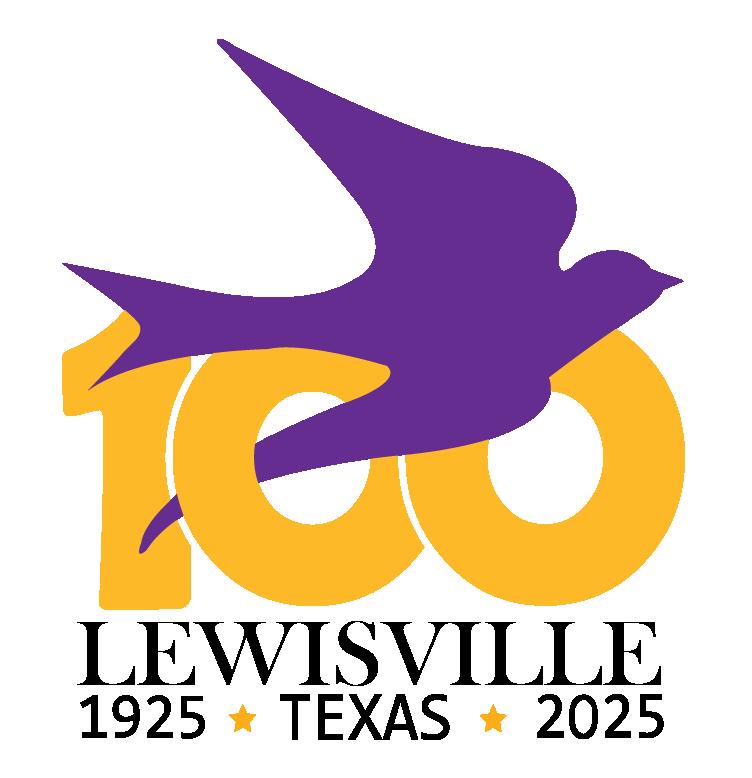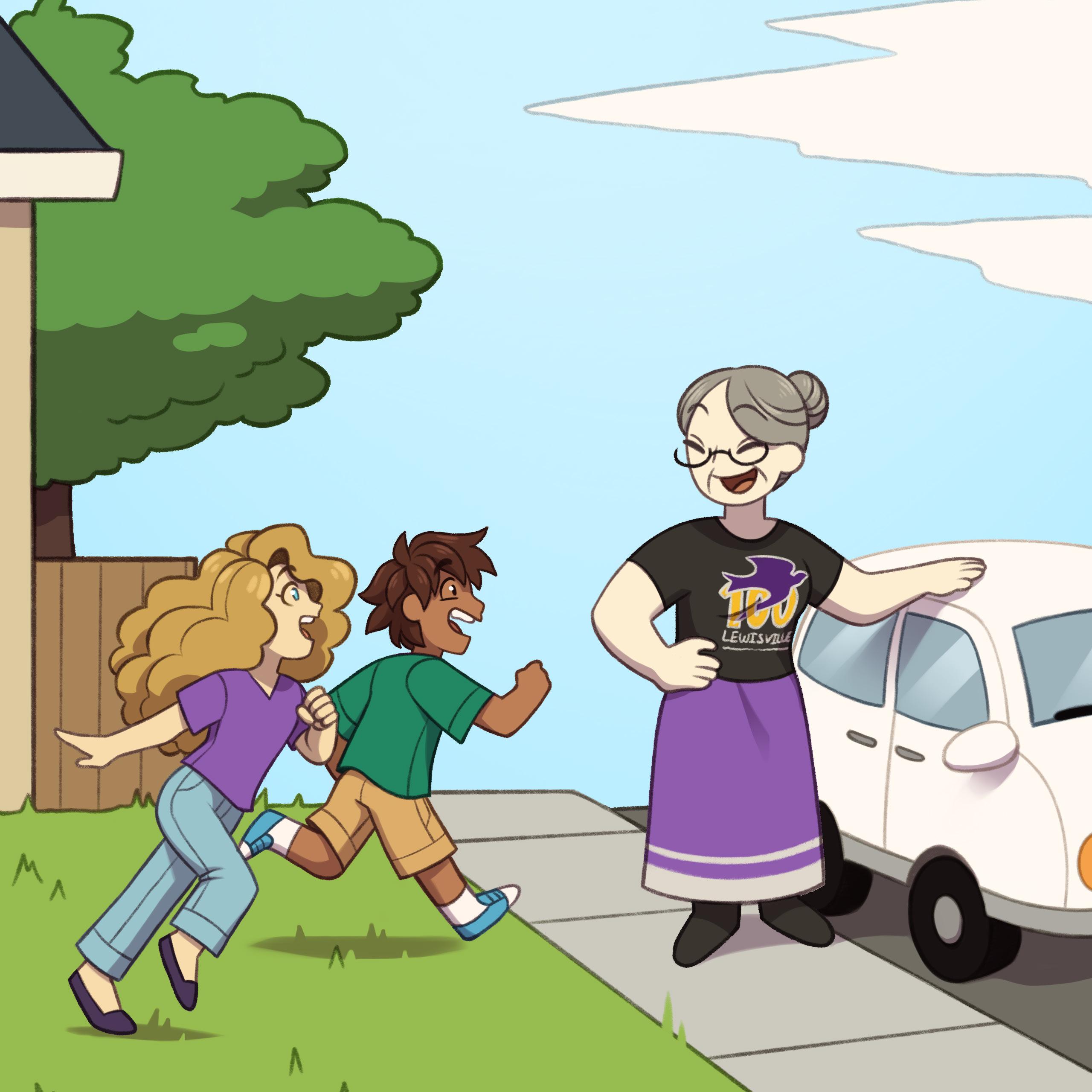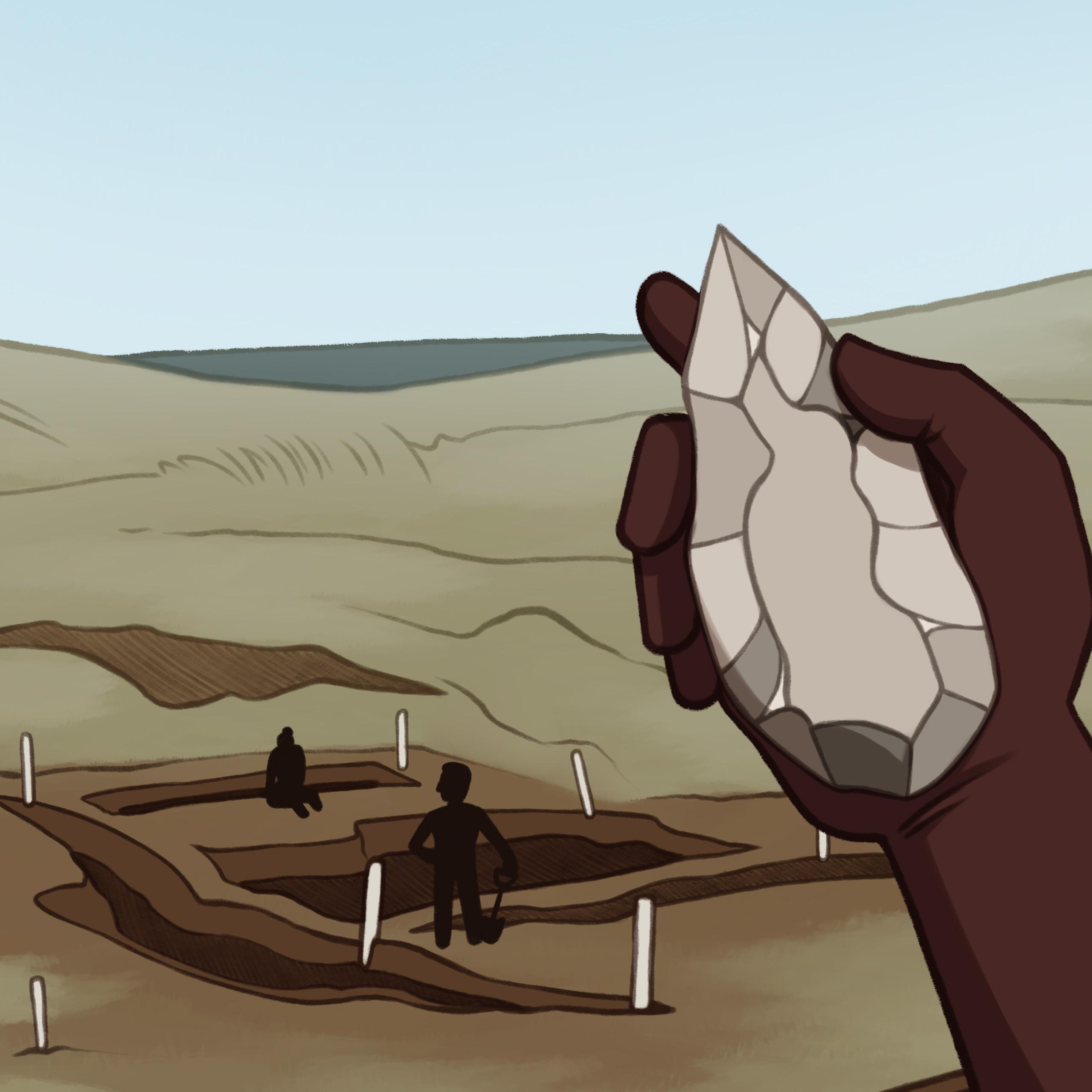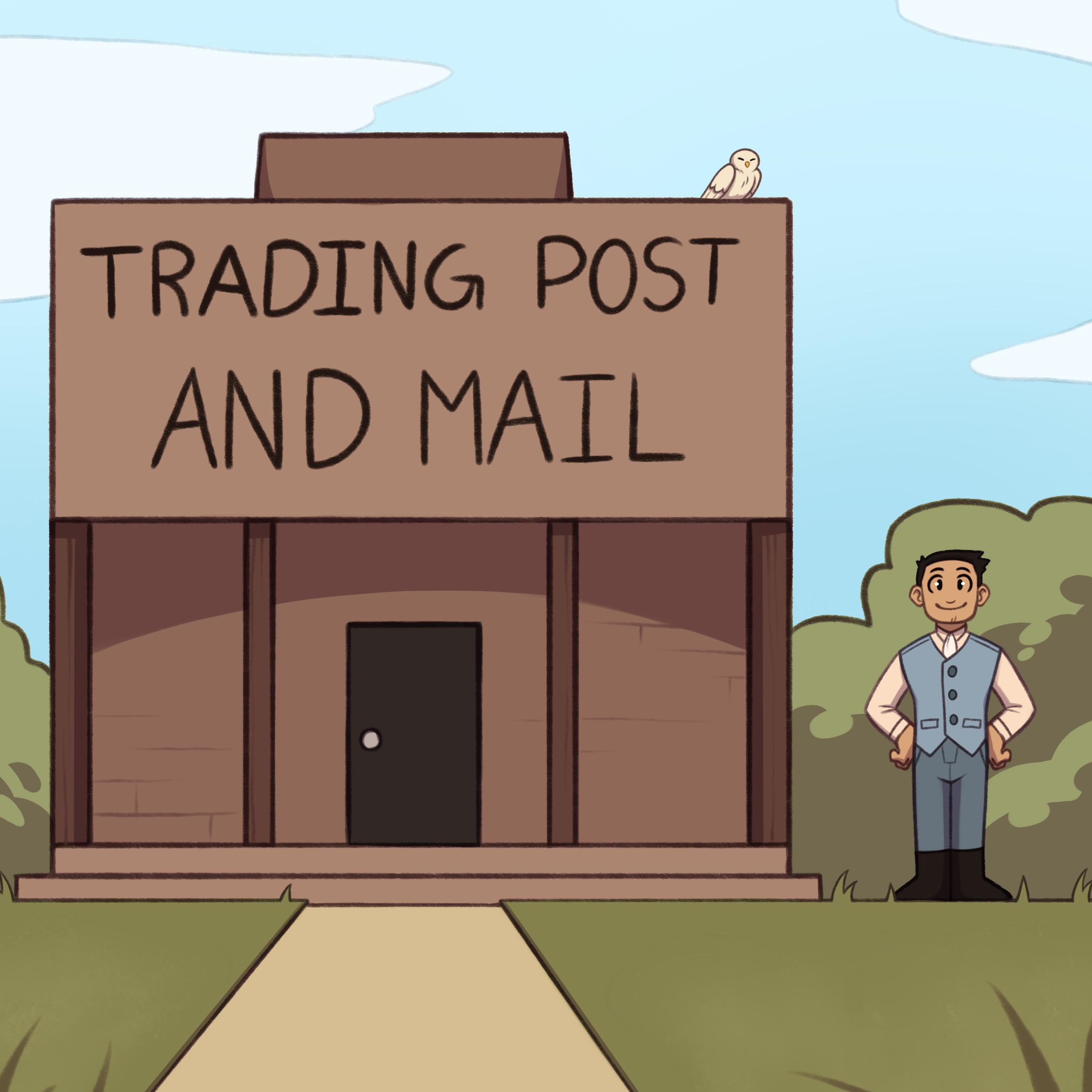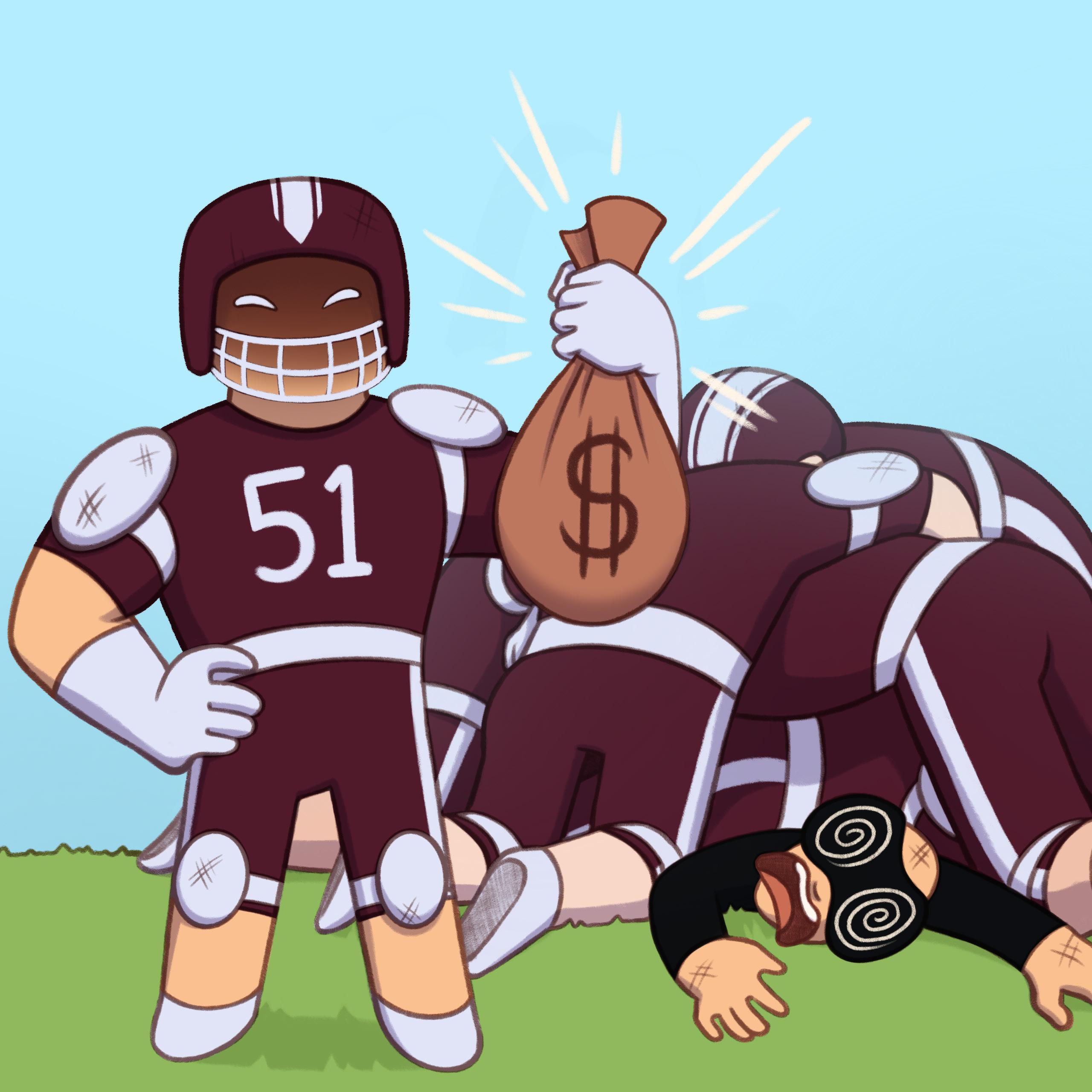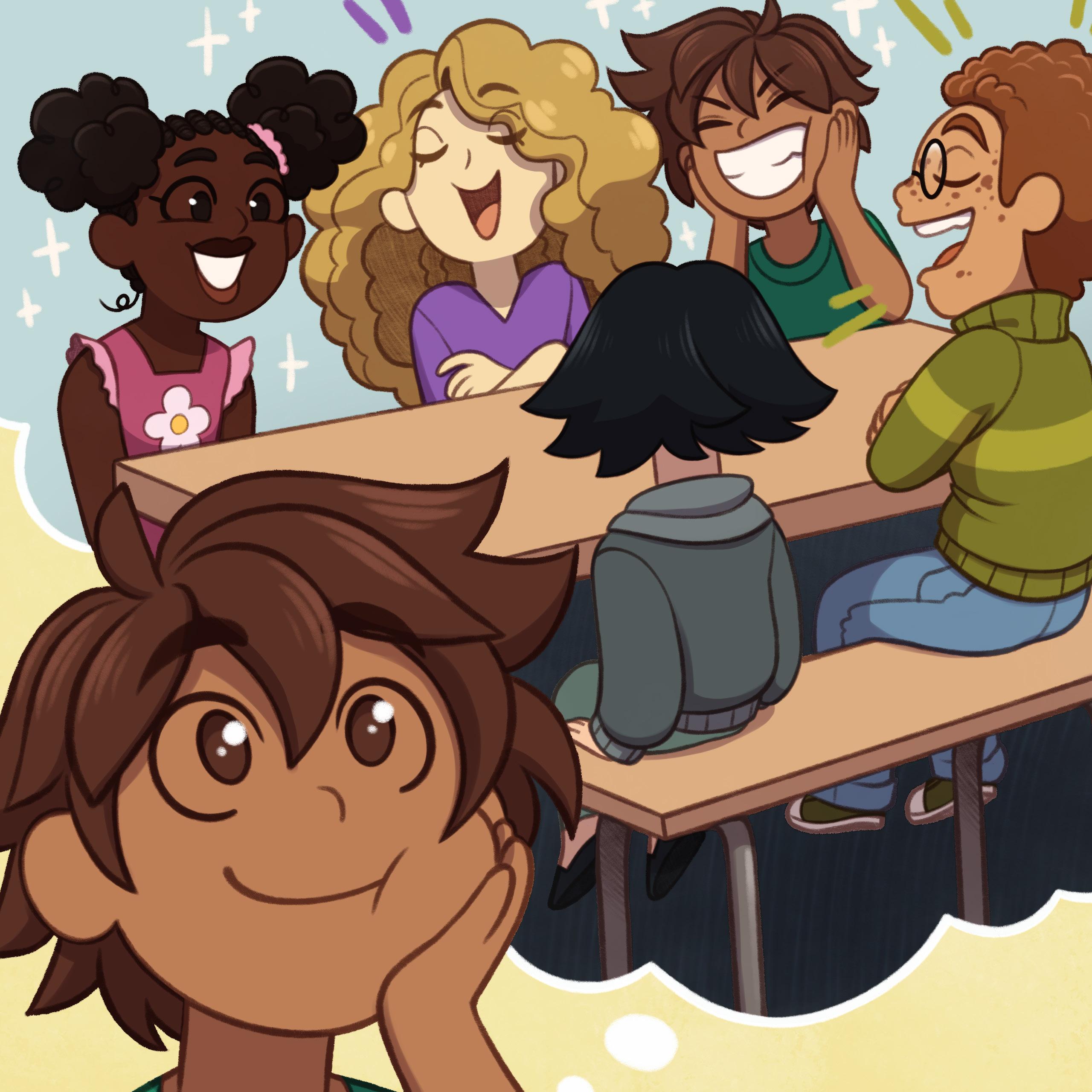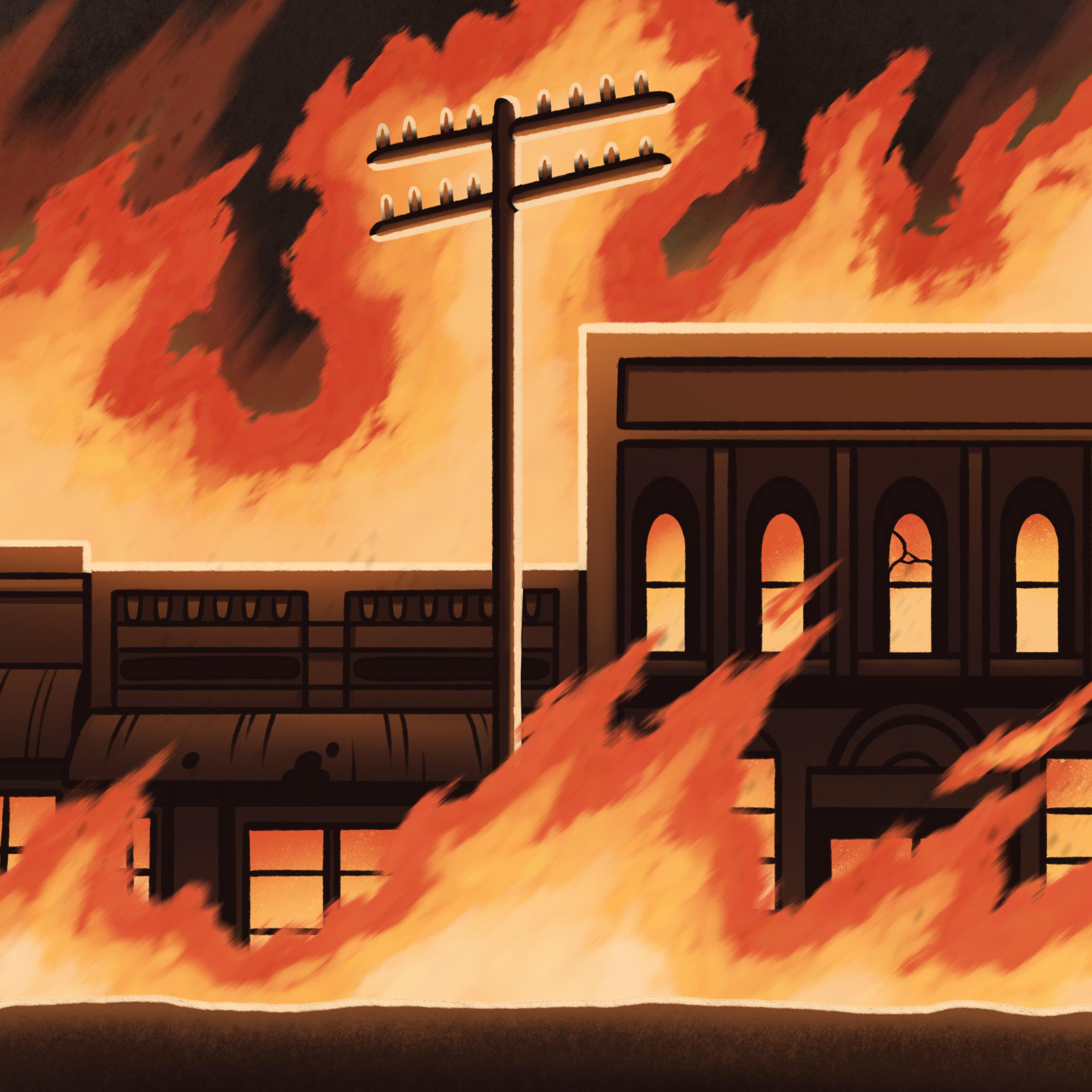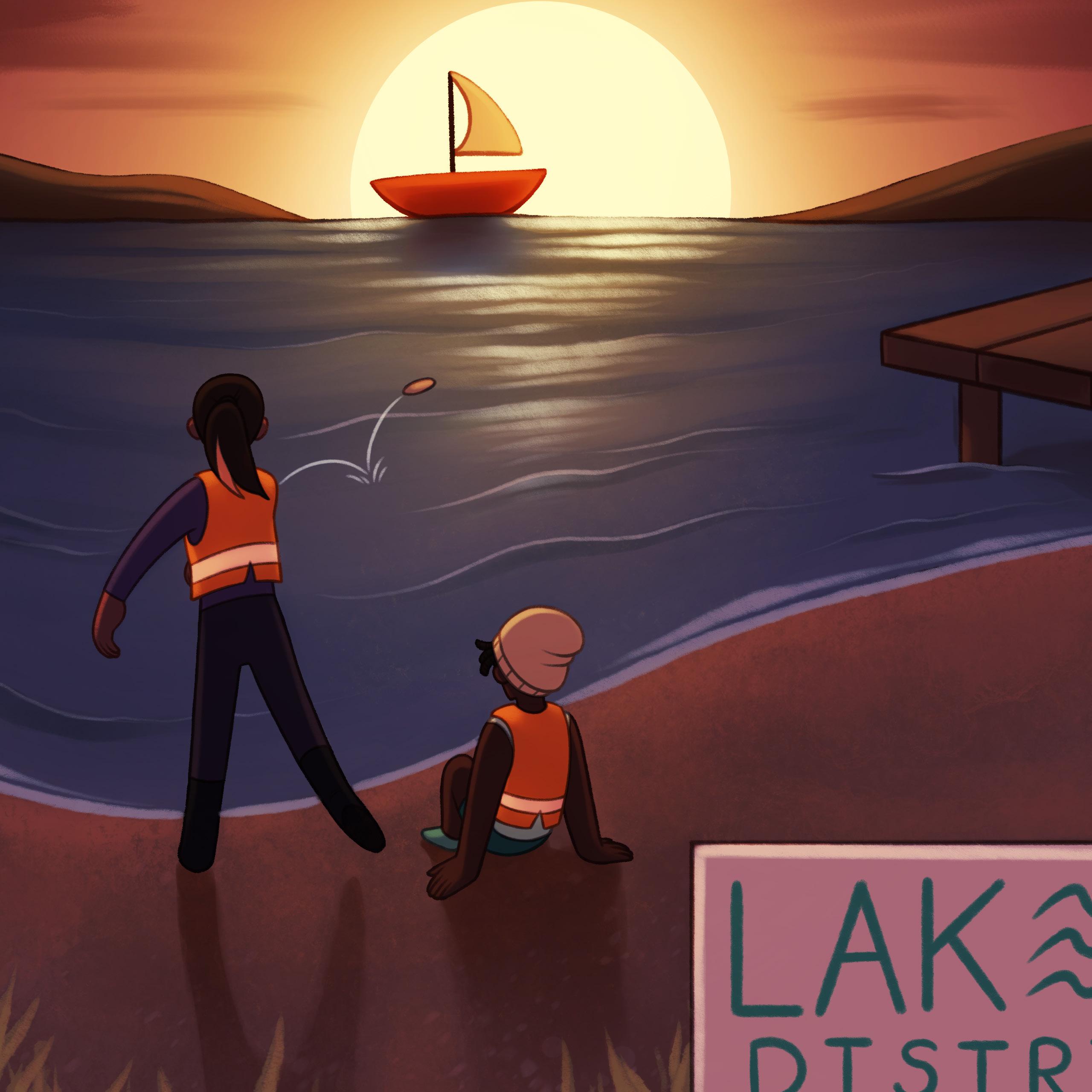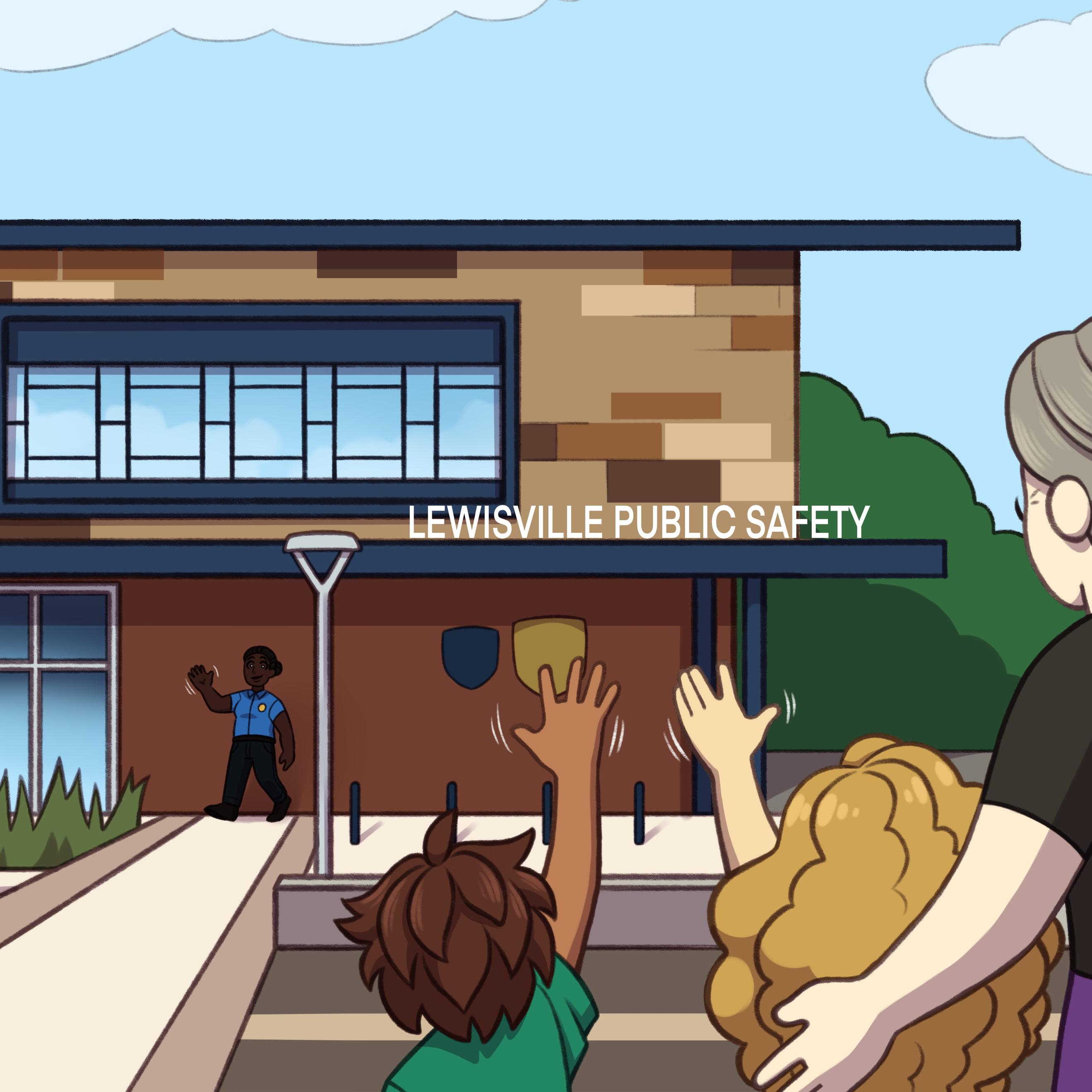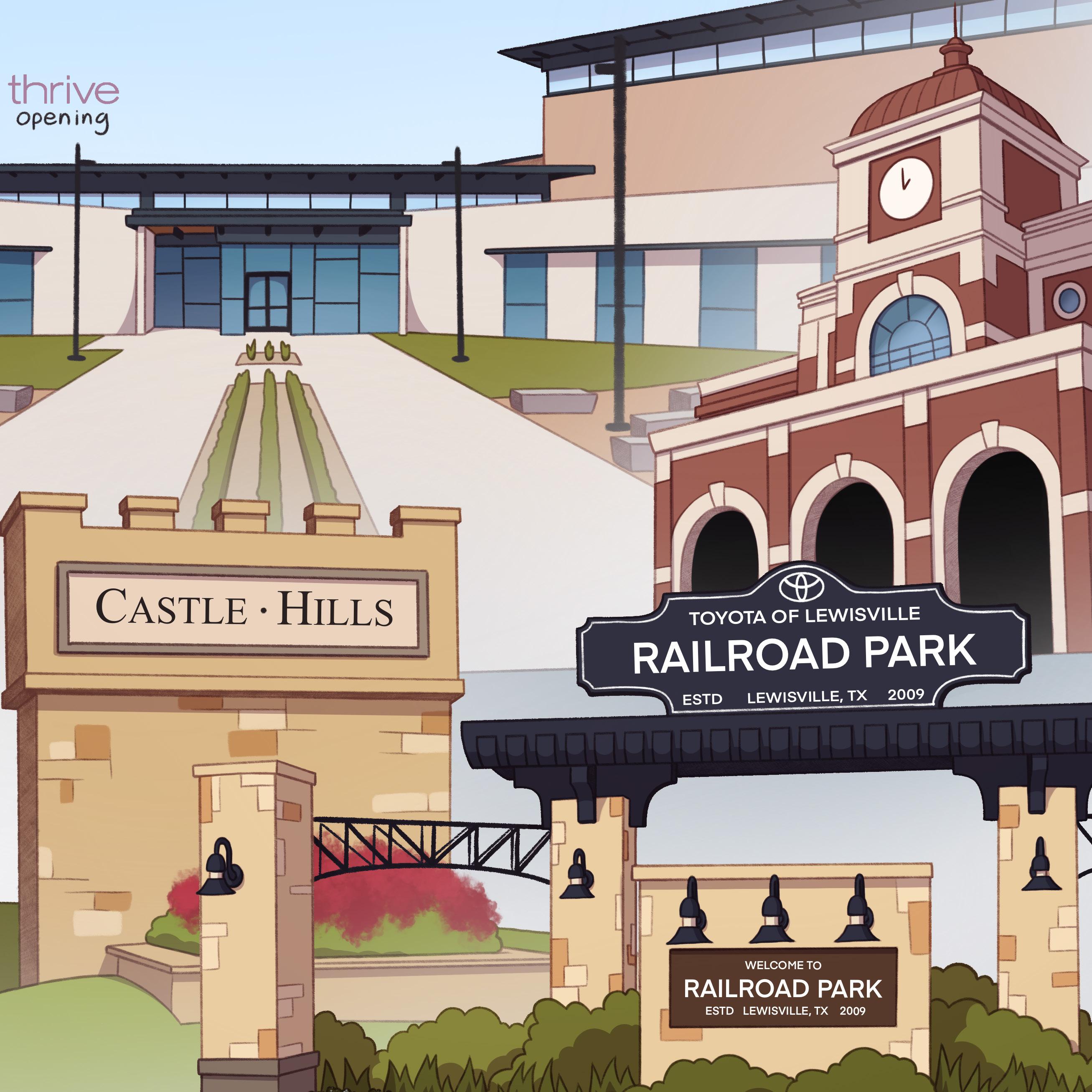La aventura del centenario de Marco
by Renee Kirchner & Allen Wiskera
Story
Illustrations by Morgan McGrath
Translated by Lauren Tatiana Gaul
This week at school, Marco and Avery learned that the year 2025 is Lewisville’s Centennial–the city’s 100th birthday! They could not wait to ask the oldest person they knew, Avery’s Grandma Bea, about it.
“Well, I am not quite that old,” Grandma Bea said with a laugh, “but I’ve lived in Lewisville for 65 years and can tell you about Lewisville’s history.”
“Tell us! Tell us!” Marco and Avery shouted.
“Let’s take a little field trip to the place where it all started,” said Grandma Bea, and they loaded into her car and set off on an adventure.
Esta semana en la escuela, Marco y Avery aprendieron que en el año 2025 será el Centenario de Lewisville, ¡El cumpleaños número 100 de la ciudad! No pueden esperar para preguntarle a la persona más grande que conocen, la abuela de Avery, Bea.
—Bueno, no soy tan vieja—, dice la abuela Bea riendo, pero yo sí he vivido en Lewisville por 65 años y puedo contarles sobre la historia de Lewisville.
—¡Cuéntanos! ¡Cuéntanos! —gritaron Marco y Avery.
—Hagamos un pequeño viaje al lugar donde empezó todo—, dijo la abuela Bea, y se subieron al carro y empezaron su aventura.
Grandma Bea pulled into a field near the lake.
“This is just a field…” Avery said.
“But not just any field,” said Grandma Bea with a smile. “Back in the 1950s, a very special arrowhead called a Clovis point was discovered near here along with other artifacts. They were more than 12,000 years old. That discovery showed that this spot was one of the oldest settlements in the Western Hemisphere!”
“Wow!” Marco said.
“Wow, indeed!” said Grandma Bea. “The City of Lewisville may be turning 100 years old this year, but its history stretches much further back…”
La abuela Bea llegó a un campo cerca del lago.
—Esto es solo un campo... — dice Avery.
—No es solo un campo—, dice la abuela Bea con una sonrisa. —En 1950, encontraron una punta de flecha llamada Clovis, con otros artefactos. ¡Esos estuvieron aquí por más de 12,000 años! Esto nos mostró que es uno de los asentamientos más viejos del hemisferio oeste—.
—¡Guau!— dice Marco.
—¡Sí, vaya!— dice la abuela Bea—. La ciudad de Lewisville va a cumplir 100 años este año, pero la historia empezó hace muchos años… —.
“The land that would become Lewisville has been home to many people, including the Clovis tribe and later Native Americans like the Keechi, Cherokee, and Caddo,” Grandma Bea continued.
“We studied some of those tribes in school,” Avery added excitedly.
Marco tried to imagine all of Lewisville without any buildings, roads, or houses–just miles and miles of prairie land.
“How does a prairie become a whole city?” he asked.
“With a lot of time and hard work,” Grandma Bea replied.
La tierra que se convertiría en Lewisville había sido el hogar de comunidades indígenas, incluyendo la tribu de los Clovis, y los nativos americanos como los Keechi, los Cherokee y los Caddo—la abuela Bea continuó.
—Estudiamos algunas de esas tribus en la escuela—, Avery dijo con entusiasmo.
Marco intentó imaginar todo Lewisville sin edificios, calles o casas- solo millas y millas de praderas.
—¿Cómo una pradera se convirtió en una ciudad?— Él preguntó.
—Con mucho tiempo y trabajo duro—, respondió la abuela Bea.
“Way back in 1841, the Republic of Texas offered free land to 600 families who intended to live there and farm it. The first two families to accept the free land and move to the area that would become Lewisville were the Holford and King families. Together, they named the area the Holford’s Prairie Settlement.”
“Why would Texas give out free land?” asked Marco.
“Well, in exchange for the free land, the families agreed to create farms and build communities,” Grandma Bea explained.
—Hace tiempo, en 1841, la República de Texas le ofreció tierras gratis a 600 familias que intentaron vivir y trabajar en ellas. Las primeras dos familias en aceptar las tierras gratis y moverse al área que se convertiría en Lewisville fueron las familias Holford y King, y juntos la llamaron Asentamiento Holford’s Prairie—.
—¿Y por qué Texas regaló tierra gratis?— preguntó Marco.
—Bueno, en intercambio por la tierra gratis, las familias acordaron crear granjas y construir comunidades—explicó la abuela Bea.
“But when did the name change from the Holford Prairie Settlement to Lewisville?” Marco asked.
“That’s a good question,” Grandma Bea said.
“In the 1850s, the settlement got its first postal station where residents could send and receive mail. The Lewisville post office was named after the man who oversaw local mail, and soon the town became known as Lewisville, too.”
—¿Pero cuándo cambió el nombre de Asentamiento Holford Prairie a Lewisville? —preguntó Marco.
—Esa es una buena pregunta,— dijo la abuela Bea.
—En los años 1850, el asentamiento tuvo su primera oficina de correos donde los residentes podian enviar y recibir correspondencia. La oficina de correos de Lewisville fue nombrada en honor del hombre que supervisaba el correo local, y poco después, el pueblo, se dio a conocer como Lewisville—.
“Over the next several years, Lewisville grew and grew.
The residents built a church for gathering, a school to educate the children, and shops to buy and sell goods.
By working together, the residents began to build a community that drew more people to the area.”
—Durante los siguientes años, Lewisville, creció y creció.
Los residentes construyeron una iglesia para reunirse, una escuela para educar a los niños y tiendas para comprar y vender bienes.
Trabajando juntos, los residentes empezaron a construir comunidades que atrajeron más y más personas al área—.
“In 1875 the Dallas & Wichita Railroad was completed and ended near Lewisville. Back in that time, a town could not grow without a railroad to transport goods and materials from one place to another. The railroads also created lots of new jobs.
The Texas & Pacific Railway arrived not long after, and the town shifted to meet it in the area now known as Old Town. Lewisville now has passenger trains that connect to cities all over Dallas and Fort Worth.”
“I want to ride the train, Grandma!” Avery said.
“We can certainly take a trip one day,” replied Grandma Bea, “but today we have the car and I have an errand to run. Let’s go, kids!”
—En 1875 se completó el ferrocarril Dallas y Wichita, que terminaba cerca de Lewisville. Antes, un pueblo no podía crecer sin un ferrocarril para transportar bienes y materiales de un lugar a otro. El ferrocarril también creó muchos trabajos nuevos.
Poco después, llegó el ferrocarril Texas y Pacifico y el pueblo cambió para dar servicios en el área conocida como Old Town Lewisville. Ahora, Lewisville tiene trenes de pasajeros que conectan las ciudades por todo Dallas y Fort Worth—.
—¡Quiero viajar en el tren, abuela!— dijo Avery.
—Podemos tomar un viaje un día— respondió la abuela Bea, —pero hoy, tenemos el carro y yo tengo que hacer las compras. ¡Vamos niños!—
As Grandma Bea drove down Main Street, she pointed out Lewisville High School.
“That’s where I am going to go to school one day,” Marco said. “I can’t wait to be a Fighting Farmer!”
Grandma Bea told Marco and Avery, “Many years ago in 1946, a man robbed the Lewisville State Bank and ran away with bags of the bank’s money. The Farmers football team was outside practicing and when they saw him, they chased him down, tackled him, and returned the money to the bank!”
“I bet that bank robber learned his lesson that day!” Marco and Avery said with a laugh.
Mientras la abuela Bea manejaba por Main Street, señaló a Lewisville High School.
—¡Eso va a ser mi escuela un día!— exclamó Marco. —No puedo esperar a ser un Fighting Farmer—.
La abuela Bea les contó a Marco y a Avery —¡hace muchos años, en 1946, un hombre robó el banco, Lewisville State Bank, y se fue corriendo con las bolsas de dinero. ¡El equipo de fútbol americano estaba afuera practicando y cuando lo vieron, lo persiguieron y regresaron el dinero al banco! —
—¡Nos imaginamos que el ladrón aprendió su lección ese día!—Marco y Avery dijeron entre risas.
“The first Lewisville high schoolers graduated over 100 years ago. As the city grew, there was a need for a large high school campus, and the current Lewisville High School was built. In the 1960s, Lewisville became one of the first cities in Texas to integrate its schools.”
“What does ‘integrate’ mean?” Avery asked.
“Many years ago,” Grandma Bea explained, “children were sent to different schools based on the color of their skin. Integration meant that, for the first time, children in Lewisville could attend the same schools.”
Marco thought about all his friends at school, each unique in their own special way and from so many different backgrounds. He was happy they could all share the same school now.
—Los primeros alumnos de Lewisville se graduaron hace más de 100 años.
Mientras crecía la ciudad, era necesario un edificio más grande para la escuela y construyeron Lewisville High School que tenemos ahora. En los 1960s, Lewisville fue una de las primeras ciudades en Texas a integrar sus escuelas—.
—¿Qué significa integración?—preguntó Avery.
—Hace muchos años —explicó la abuela Bea—, mandaban a los niños a escuelas diferentes dependiendo del color de su piel. La integración significa que, por primera vez, los niños en Lewisville podían entrar a la misma escuela—.
Marco pensaba en sus amigos de la escuela, todos especiales a su manera y con diferentes historias. Él estaba feliz de que todos pudieran ir a la misma escuela ahora.
Avery looked out the window at all the buildings passing by. They had been there as long as she could remember–which seemed like a very long time.
“But how did Lewisville actually become a city?” Avery asked.
“That’s an excellent question,” Grandma Bea replied. “Back in 1918, a fire swept through downtown Lewisville, burning up several buildings, and the people realized they needed a fire department. In 1925 Lewisville residents voted to incorporate, which meant that residents would pay taxes to help fund a fire department, a police department, and more services to help the city grow.”
Avery miró por la ventana y vio todos los edificios pasando. Ellos han estado allí durante todo este tiempo que ella podía recordar, lo que parecía como si fuera hace ya mucho tiempo.
—¿Pero cómo Lewisville se convirtió en una ciudad?—preguntó Avery.
—Esa es una pregunta excelente —dice la abuela, Bea, —En 1918, un incendio pasó por el centro de Lewisville quemando varios edificios, y las personas se dieron cuenta de que necesitaban un departamento de bomberos. En 1925, los residentes de Lewisville votaron para incorporarse, lo que significaba es que los residentes pagarían impuestos para ayudar a fundar el departamento de bomberos, la policía y más servicios para que pudiera crecer la ciudad—.
“Lewisville Lake was formed in 1957 and helped bring new people to the city,” Grandma Bea said.
“Wait!” Marco and Avery were surprised. “So the lake hasn’t always been here?”
“No,” Grandma Bea explained. “The Lewisville Dam was completed in 1955, but the area was in the midst of a seven-year drought so the lake didn’t actually fill until the rains finally returned in 1957. In fact, Lewisville Lake is only a few years older than me!”
Marco and Avery couldn’t imagine Lewisville without its lake. Last summer, Marco’s dad had taught them how to skip stones across its surface when the water was still. They loved to hike around its shore and wade in its cool water to look for skipping stones.
—El lago de Lewisville fue formado en 1957, y atrajo más personas a la ciudad—, dijo la abuela Bea.
—¡Espera! —Marco y Avery estaban sorprendidos — ¿Entonces el lago no siempre ha estado allí?
—No—, explicó la abuela, Bea—. La presa de Lewisville se completó en 1955, sin embargo, la zona se encontraba en una época de sequía que se prolongó durante siete años, por lo que el lago no se llenó completamente hasta que las precipitaciones volvieron en 1957. ¡De hecho, el lago de Lewisville, solo es unos años más viejo que yo! —
Marco y Avery no podían imaginar Lewisville sin su lago. El verano pasado, el papá de Marco les había enseñado a lanzar piedras por la superficie cuando el agua estaba tranquila. Les encantaba caminar por la orilla y chapotear en sus aguas frescas para buscar piedras que lanzar.
Grandma Bea pulled up to the library to return her books. Marco and Avery couldn’t wait to go inside!
“The library wasn’t always this big, beautiful building,” Grandma Bea said as they entered. “Lewisville’s first library was in the basement of a church and run by volunteers. The first librarian was hired in 1961. Since then, the library has had seven different locations!”
“A library is an important part of a city,” Grandma Bea continued. “The library provides free services to the public.”
“Like books to check out?” Avery asked.
“Yes, and computers to use, free educational programs, the Hive Makerspace, and more. The library connects people and helps to build a more informed community.”
La abuela Bea llegó a la biblioteca para regresar sus libros. Marco y Avery no podían esperar a entrar.
—La biblioteca no siempre fue este edificio grande y bonito— La abuelita Bea dijo mientras entraban.
—La primera biblioteca de Lewisville estaba dentro de una iglesia y estaba a cargo de voluntarios. La primera bibliotecaria fue contratada en 1961. Desde entonces, la biblioteca ha estado en siete diferentes localidades—.
La biblioteca es un espacio importante para la ciudad —continuó la abuela Bea. La biblioteca ofrece servicios gratis al público.
—¿Cómo libros prestados?—preguntó Avery.
—Sí, y computadoras para usar, programas educativos gratis, el Hive Makerspace y más. La biblioteca conecta a las personas, y ayuda a construir una comunidad más educada—.
“I’ve been visiting the library since I was a little girl dancing at storytime!” Grandma Bea said.
“You still love to dance!” Avery giggled. She and Marco had danced with Grandma Bea at Western Days and the Sounds of Lewisville concerts many times.
“When I was just nine years old, Lewisville was part of a giant music event called the Texas International Pop Festival. I went with my parents and danced more than I’ve ever danced before!” Grandma Bea said, wiggling her hips.
Marco and Avery laughed at the thought of Grandma Bea as a little girl.
—¡Yo he estado visitando la biblioteca desde que yo era una niña pequeña, bailando en la hora de cuentos! —dice la abuela Bea.
—¡Todavía amas bailar!— dice Avery riéndose. Ella y Marco han bailado con la abuela Bea en Western Days y los conciertos Sounds of Lewisville muchas veces.
—Cuando yo tenía solo nueve años, Lewisville era parte de un evento musical gigante llamado Texas International Pop Festival. Yo fui con mis padres y baile como nunca— dijo la abuela Bea, moviendo las caderas.
Marco y Avery se rieron al imaginar a la abuela Bea como una niña pequeña.
As they made their way back to the car, Avery and Marco spotted a police officer leaving the new Tittle McFadden Public Safety Center. They waved excitedly. The police officer waved back and gave them a big smile.
“I remember when Lewisville hired its first female police officer back in 1976,” Grandma Bea said. “I was just 16 years old, and it inspired me to work for the City of Lewisville, too!”
“You were a police officer?” Marco gasped.
“No, I wasn’t quite that brave,” Grandma Bea said. “I worked as a librarian for 20 years.”
“That’s why Grandma Bea loves books so much,” Avery said.
“And knows so much about history!” Marco added.
Mientras regresaban a su carro, Avery y Marco vieron un oficial de policía saliendo del nuevo Tittle McFadden Public Safety Center. Lo saludaron muy emocionados y el oficial de policía los saludó de vuelta con una gran sonrisa.
—Recuerdo cuando en Lewisville contrataron a la primera mujer oficial de policía en 1976—, dijo la abuela Bea. —¡Yo solo tenía 16 años, y me inspiró a trabajar para la ciudad de Lewisville también!
—¿Tu fuiste una oficial de policía? —Marco dijo con asombro.
—No, yo no era tan valiente—, dijo la abuela Bea. Yo trabajé en la biblioteca por 20 años.
—Por eso la abuela Bea ama tanto los libros—, dijo Avery.
—¡Y sabe mucho de historias!— agregó Marco.
As Grandma Bea started to drive home, she continued, “In the past several years, Lewisville has grown by leaps and bounds. As a little girl, I couldn’t have imagined what Lewisville would become.”
Mientras la abuela Bea empezó a manejar de regreso a casa, ella continuó, —en los últimos años. Lewisville ha crecido a pasos agigantados. Cuando era niña pequeña, no hubiera imaginado en lo que se convertiría Lewisville—.
“Just think,” Grandma Bea said. “In 10 years, you will both be graduating from high school!”
Marco and Avery looked out the window as the city passed by. Ten years didn’t seem like such a long time considering all they’d learned today.
What would Lewisville look like when they were Grandma Bea’s age? What would it look like in another 100 years?
“When I grow up, I want to be a librarian just like you, Grandma!” Avery said.
Marco considered all the possibilities the future held. “Maybe I’ll be a fireman? Or a teacher? Or the mayor!” Marco said.
“Don’t worry, Marco,” Grandma Bea said with a kind smile in the rear-view mirror. “You still have plenty of time to figure that out.”
—Solo imaginen—, dijo la abuela Bea. —En 10 años, los dos se estarán graduando del High School—.
Marco y Avery vieron por la ventana mientras paseaban por la ciudad. Diez años no parece mucho, considerando todo lo que aprendieron hoy.
¿Cómo se verá Lewisville cuando ellos lleguen a la edad de la abuela Bea? ¿Cómo será en 100 años?
—Cuando yo crezca, quiero ser bibliotecaria como tu abuela, —dijo Avery.
Marco pensó en todas las posibilidades que le ofrecía el futuro. —¿Quizá seré bombero? ¿O profesor? ¡O alcalde!—dijo Marco.
—No te preocupes—, Marco, dijo la abuela Bea con una amable sonrisa por el retrovisor. —Todavía tienes mucho tiempo para decidirlo—.
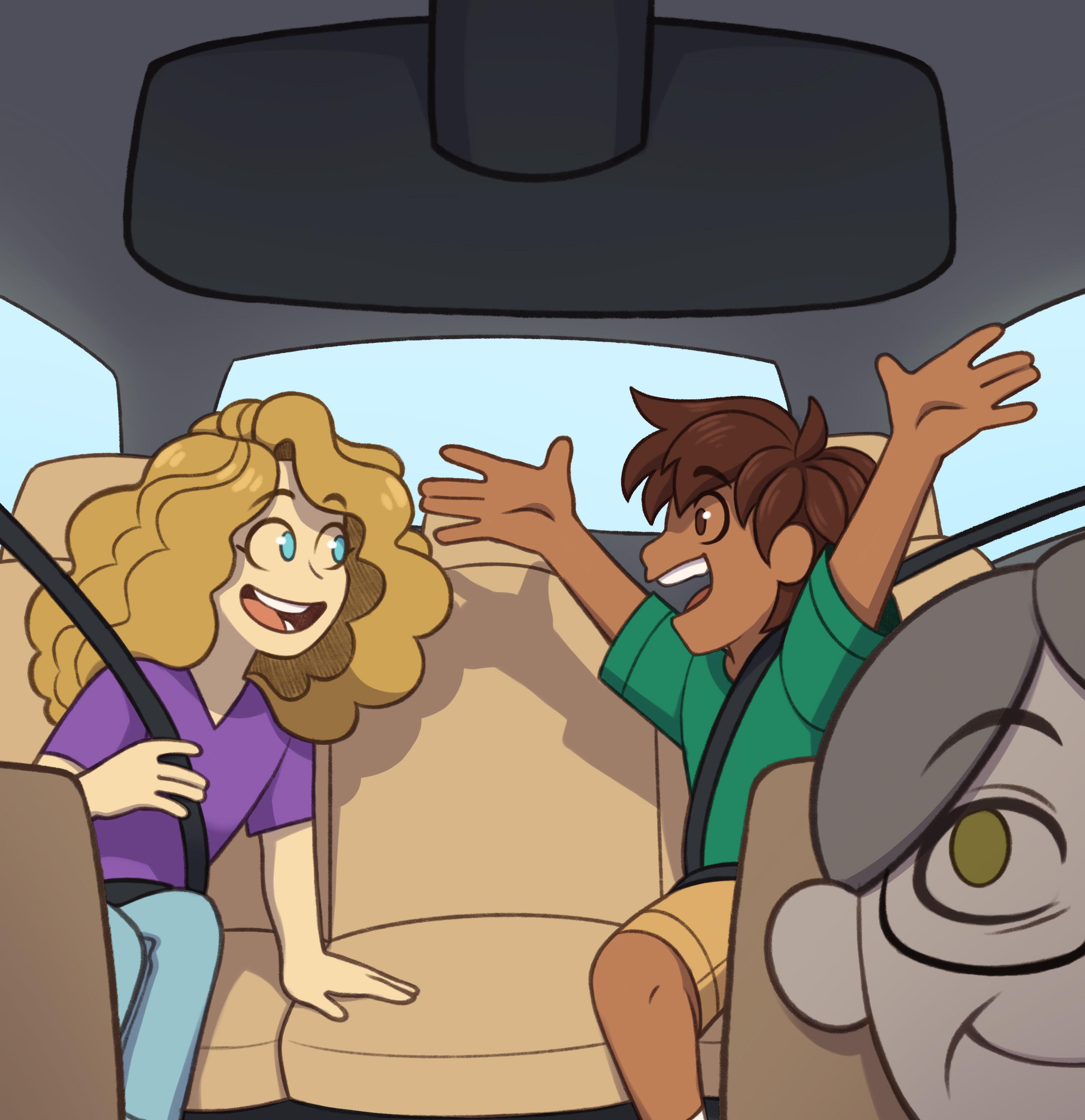
Author’s Note: This book was developed in collaboration with the Centennial Publications Subcommittee for second-graders in LISD classrooms to commemorate Lewisville’s centennial and provide a local history to help contextualize the last century. A timeline of events was compiled by subcommittee, and further research was conducted by the authors using the Lewisville Public Library’s local history collection as well as city and county websites. This abridged version of Lewisville’s history is intended for a secondgrade audience, emphasizing the city’s transformation from a rural settlement to the vibrant community we recognize today. Due to the limitations of the picture book format–length, audience, etc.–much of Lewisville’s rich history could not be included. Readers are encouraged to explore lewisvilletx100.com or visit the Lewisville Public Library for a more comprehensive view of Lewisville’s history.
Nota del Autor: Este libro fue desarrollado en colaboración con el Subcomité de Publicaciones del Centenario para los alumnos de segundo grado en las aulas de LISD para conmemorar el centenario de Lewisville y proporcionar una historia local para ayudar a contextualizar el siglo pasado. El subcomité recopiló una cronología de los acontecimientos y los autores llevaron a cabo una investigación adicional utilizando la colección de historia local de la Biblioteca Pública de Lewisville, así como los sitios web de la ciudad y el condado. Esta versión abreviada de la historia de Lewisville está dirigida a un público de segundo grado y hace hincapié en la transformación de la ciudad desde un asentamiento rural hasta la vibrante comunidad que reconocemos hoy en día. Debido a las limitaciones del formato de libro ilustrado -longitud, público, etc.- no se ha podido incluir gran parte de la rica historia de Lewisville. Se anima a los lectores a explorar lewisvilletx100.com o a visitar la Biblioteca Pública de Lewisville para.
Copyright 2025
City of Lewisville

